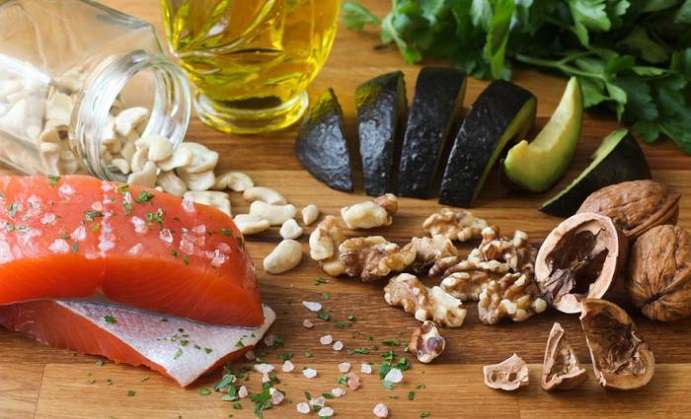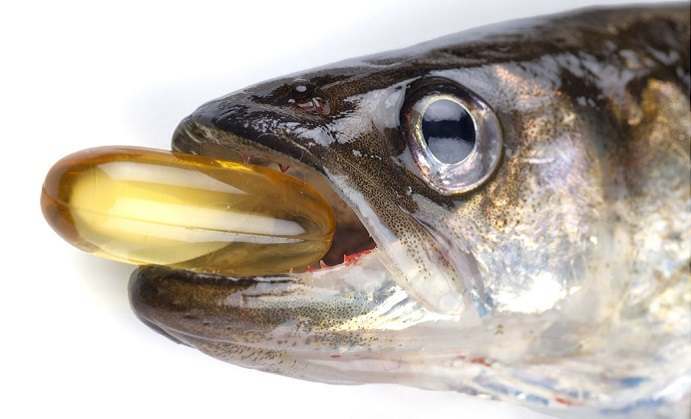Summary
Omega-3 fatty acids belong to an extensive group of fats called polyunsaturated fats. The omega-3 chemical structure is made up of double bonds, two or more in number. Omega-3 fatty acids are an essential part of cell membranes all over the body that are responsible for maintaining the function of the cell receptors in these membranes. Omega-3 is responsible for the preliminary point for building hormones that regulate blood clotting, inflammation, the contraction and relaxation of artery walls. Omega-3 also binds to receptors in cells that regulate genetic function. They have been shown to assist in preventing heart disease and stroke, eczema, rheumatoid arthritis, and may play a preventive role in cancer and help control lupus. There are 11 types of Omega-3 fatty acids, but these three are the most important:
 Alpha-linolenic acid (ALA) – The most common omega-3 fatty acid found in vegetable oils and nuts (especially walnuts), leafy vegetables, flax seeds and flaxseed oil, and some animal fat (grass-fed animals).
Alpha-linolenic acid (ALA) – The most common omega-3 fatty acid found in vegetable oils and nuts (especially walnuts), leafy vegetables, flax seeds and flaxseed oil, and some animal fat (grass-fed animals).- Eicosapentaenoic acid (EPA) and docosahexaenoic acid (DHA) – These are found in fish, so they are also called marine omega-3s.
The deficiency in omega-3 fatty acid can cause depression, impairment in visual and neurological development in infants, increase inflammation, asthma, dementia, and much more.
- ALA (Alpha-Linolenic Acid)
This is a carboxylic acid made up of 18 carbon chains and three cis double bonds. ALA is found in vegetable oils and plant food and it needs to be changed into DHA or EPA before it can be absorbed by the body. Some researchers suggest that less than 1% of ALA is converted to physiologically effective levels of EPA and DHA. The unconverted ALA stays inactive in the body and is used as a source of energy. According to some studies, ALA reduces the risk of heart diseases whereas other studies suggest its role in increasing the risk of prostate cancer while DHA and EPA have a protecting effect in this case.
- EPA (Eicosapentaenoic Acid)
Chemically, EPA is a carboxylic acid with a 20-carbon chain and five cis double bonds. EPA is a polyunsaturated fatty acid (PUFA) that acts as an originator for prostaglandin-3. The role of our inflammatory system depends on prostaglandins. Many of these prostaglandins are made directly from EPA and they have an anti-inflammatory effect. Hence, the possibility of inflammation and inflammation-related disease can be lowered through the consumption of foods that are rich in EPA, such as algae and fatty fish oils. It also reduces the signs of depression. One study suggested that EPA lowered the feeling of hot flashes during menopause in many women.
- DHA (Docosahexaenoic Acid)
 Docosahexaenoic acid (DHA) is another omega-3 fatty acid. Structurally, it is a carboxylic acid with a 22-carbon chain. DHA is a chief structural constituent of the human brain, cerebral cortex, skin, sperm, testicles, and retina. It can be manufactured from alpha-linolenic acid or gained straight from breast milk, fish oil or algae oil. DHA improves vision in children, is important for high blood pressure, brain function, arthritis, some cancers and type 2 diabetes. Low levels of DHA may cause many disabilities and diseases like ADHD, Alzheimer’s disease, and dementia. It prevents heart disease by reducing the detrimental LDL cholesterol.
Docosahexaenoic acid (DHA) is another omega-3 fatty acid. Structurally, it is a carboxylic acid with a 22-carbon chain. DHA is a chief structural constituent of the human brain, cerebral cortex, skin, sperm, testicles, and retina. It can be manufactured from alpha-linolenic acid or gained straight from breast milk, fish oil or algae oil. DHA improves vision in children, is important for high blood pressure, brain function, arthritis, some cancers and type 2 diabetes. Low levels of DHA may cause many disabilities and diseases like ADHD, Alzheimer’s disease, and dementia. It prevents heart disease by reducing the detrimental LDL cholesterol.
ALA to EPA to DHA Conversion Process
ALA should be changed into DHA or EPA to be “active”. Studies state that only 0.5–5% is changed into DHA and 1–10% is changed into EPA in humans. This conversion process mainly depends on the level of Vitamin B6, copper, magnesium, Vitamin B7, calcium, iron and zinc in the body. Our diet these days may be deficient in these important nutrients, mostly amongst vegetarians.
EPA and DHA are the most important omega-3 fatty acids for our body. They are found in foods as discussed earlier, and nowadays, there are a lot of omega-3 supplements available on the market to meet this need.
Do you want to find an effective Omega-3 supplement? Check out our top rated Omega-3 products










